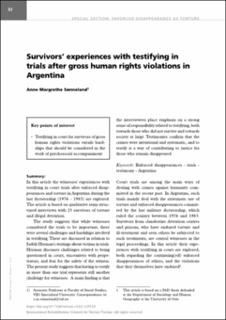| dc.contributor.author | Sønneland, Anne Margrethe | |
| dc.date.accessioned | 2024-04-05T06:18:20Z | |
| dc.date.available | 2024-04-05T06:18:20Z | |
| dc.date.created | 2022-01-04T14:14:34Z | |
| dc.date.issued | 2021 | |
| dc.identifier.citation | Journal on Rehabilitation of Torture Victims and Prevention of Torture. 2021, 31 (3), 32-44. | en_US |
| dc.identifier.issn | 1018-8185 | |
| dc.identifier.uri | https://hdl.handle.net/11250/3124952 | |
| dc.description.abstract | In Argentina, persons who were held detained-disappeared during the last military dictatorship (1976 - 1983) now testify in trials related to the military regime’s use of enforced disappearances, torture and other crimes. The trials were re-initiated in 2005, after more than a decade of impunity. Trials have been taking place all over the country since then. Trials are related either to individual perpetrators, individual victims, or to places where the crimes were committed. Many witnesses testify in a number of trials. In this article, I explore experiences with testifying in these trials, based on interviews with 23 persons who were held ‘detained-disappeared’ for political reasons during the dictatorship. The witnesses have testified both to what they themselves have endured, and to crimes committed towards persons who remain forcefully disappeared.
The testimonies of persons who were held detained-disappeared are central in the trials, as there is often little evidence besides these testimonies. The interviewees express a strong sense of responsibility related to testifying in court, due to the central role of these testimonies as well as the witnesses’ responsibility towards those who remain forcefully disappeared or were killed. Through testimonies in court, persons who remain forcefully disappeared are presented as persons with agency and often with a political commitment; not only as victims of serious violations of human rights.
I discuss testimonies in court as a longer process, which begins before the trial is initiated and where the testimony itself is the main event. To testify in court may lead to distress, and there is a worry about re-traumatisation. Several aspects of trials have an influence on the experience with testifying, among them the presence and attitude of the defendants; the presence of threats, the ways in which questions are asked during testimonies, and how many trials the witness has testified in. | en_US |
| dc.language.iso | eng | en_US |
| dc.publisher | International Rehabilitation Council for Torture Victims | en_US |
| dc.rights | Attribution-NonCommercial-NoDerivatives 4.0 Internasjonal | * |
| dc.rights.uri | http://creativecommons.org/licenses/by-nc-nd/4.0/deed.no | * |
| dc.subject | Argentina | en_US |
| dc.subject | testimony | en_US |
| dc.subject | trials | en_US |
| dc.subject | enforced disappearances | en_US |
| dc.title | Survivors’ experiences with testifying in trials after gross human rights violations in Argentina | en_US |
| dc.type | Peer reviewed | en_US |
| dc.type | Journal article | en_US |
| dc.description.version | publishedVersion | en_US |
| dc.rights.holder | Copyright (c) 2021 Torture Journal | en_US |
| dc.source.pagenumber | 32-44 | en_US |
| dc.source.volume | 31 | en_US |
| dc.source.journal | Journal on Rehabilitation of Torture Victims and Prevention of Torture | en_US |
| dc.source.issue | 3 | en_US |
| dc.identifier.doi | 10.7146/torture.v32i3.125118 | |
| dc.identifier.cristin | 1974445 | |
| cristin.ispublished | true | |
| cristin.fulltext | original | |
| cristin.qualitycode | 1 | |

